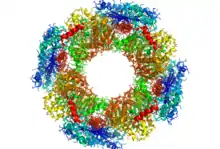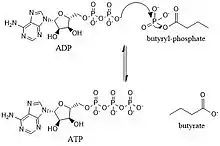Butyrate kinase
In enzymology, a butyrate kinase (EC 2.7.2.7) is an enzyme that catalyzes the chemical reaction
- ADP + butyryl-phosphate ATP + butyrate
| Butyrate kinase | |||||||||
|---|---|---|---|---|---|---|---|---|---|
 Butyrate kinase as an octomer. | |||||||||
| Identifiers | |||||||||
| EC number | 2.7.2.7 | ||||||||
| CAS number | 37278-14-1 | ||||||||
| Databases | |||||||||
| IntEnz | IntEnz view | ||||||||
| BRENDA | BRENDA entry | ||||||||
| ExPASy | NiceZyme view | ||||||||
| KEGG | KEGG entry | ||||||||
| MetaCyc | metabolic pathway | ||||||||
| PRIAM | profile | ||||||||
| PDB structures | RCSB PDB PDBe PDBsum | ||||||||
| Gene Ontology | AmiGO / QuickGO | ||||||||
| |||||||||
Thus, the two substrates of this enzyme are ADP and butyryl-phosphate, whereas its two products are ATP and butyrate.
This enzyme belongs to the family of transferases, specifically those transferring phosphorus-containing groups (phosphotransferases) with a carboxy group as acceptor. The systematic name of this enzyme class is ATP:butanoate 1-phosphotransferase. This enzyme participates in butyrate metabolism.
This enzyme is transcribed from the gene buk,[1][2] which is part of the ASHKA super family.[3]
Mechanism

- ADP + butyryl-phosphate ATP + butyrate
The reaction above is a nucleophilic substitution reaction. An electron pair from an oxygen on ADP attacks the phosphorus on butyryl-phosphate, breaking the bond between phosphorus and oxygen to create ATP and butyrate. The arrow-pushing mechanism is shown above.
The reaction can also occur in the reverse direction, as shown below, under certain fermentation conditions.[4][5]
- ATP + butyrate ADP + butyryl-phosphate
Structure
As of 2015, two structures have been solved for this class of enzymes, with PDB accession codes 1SAZ and 1X9J. The study conducted to solve 1SAZ was retracted in 2012 due to fact that the data was used without the permission of the sole custodian.[6]
The investigators of the study that produced the crystallization of 1X9J hypothesized that the enzyme was an octomer formed from dimers.[3] The crystallized form has a radius of 7.5 nm which corresponded to a molecular weight of 380kDa. Because a monomer of buk2 is about 43kDa, it was believed that the enzyme itself was either an octomer or a nonamer. Investigators hypothesized that the enzyme was an octomer since most of the proteins within the ASHKA super family form dimers.
Function
Butyrate kinase is active within the human colon.[1] To form butyrate, two molecules of acetyl-CoA are combined and reduced to produce butyryl-CoA. Butyryl CoA is then converted into butyrate through two reactions. The first reaction converts butyryl-CoA to butyryl-phosphate by using the phosphotransbutyrylase enzyme.[2] Butyryl-phosphate is then converted into butyrate by using butyrate kinase and in the process, releases ATP.[7][8]
Butyrate plays an important role within cells as it affects cellular proliferation, differentiation, and apoptosis.[9][10]
Because of the significant roles that butyrate plays within cells, it is essential that butyrate kinase is functioning correctly, which can be done through regulation of the enzyme. One study has previously found that butyrate kinase is not regulated by its end-products or other acids such as acetic acid,[11] but more studies need to be conducted to further elucidate the regulation of butyrate kinase.
Disease relevance
As stated in the previous section, butyrate is involved with multiple cellular functions. Because of its involvement with these functions, it is hypothesized that butyrate can act as a protective agent against colon cancer and various inflammatory bowel diseases.[7][9][10][12] Butyrate plays a key role in colon cancer by switching its role concerning cellular proliferation and apoptosis depending on the state and conditions of the cell.[9][10] Butyrate also possesses anti-inflammatory effects to decrease colonic inflammation such as ulcerative colitis.[9] One study specifically identified the transcription factor NF-kB as a target of butyrate to decrease the number of pro-inflammatory cytokines.[7]
References
- Louis P, Duncan SH, McCrae SI, Millar J, Jackson MS, Flint HJ (April 2004). "Restricted distribution of the butyrate kinase pathway among butyrate-producing bacteria from the human colon". Journal of Bacteriology. 186 (7): 2099–106. doi:10.1128/jb.186.7.2099-2106.2004. PMC 374397. PMID 15028695.
- Walter KA, Nair RV, Cary JW, Bennett GN, Papoutsakis ET (November 1993). "Sequence and arrangement of two genes of the butyrate-synthesis pathway of Clostridium acetobutylicum ATCC 824". Gene. 134 (1): 107–11. doi:10.1016/0378-1119(93)90182-3. PMID 8244020.
- Diao J, Cooper DR, Sanders DA, Hasson MS (June 2003). "Crystallization of butyrate kinase 2 from Thermotoga maritima mediated by vapor diffusion of acetic acid". Acta Crystallographica D. 59 (Pt 6): 1100–2. doi:10.1107/s0907444903007832. PMID 12777787.
- Wiesenborn DP, Rudolph FB, Papoutsakis ET (February 1989). "Phosphotransbutyrylase from Clostridium acetobutylicum ATCC 824 and its role in acidogenesis". Applied and Environmental Microbiology. 55 (2): 317–22. doi:10.1128/AEM.55.2.317-322.1989. PMC 184108. PMID 2719475.
- Rogers, P (1986). "Genetics and biochemistry of Clostridium relevant to development of fermentation processes". Advances in Applied Microbiology Volume 31. Advanced Application of Microbiology. Advances in Applied Microbiology. 31. pp. 1–60. doi:10.1016/s0065-2164(08)70438-6. ISBN 9780120026319.
- Diao, J.; Hasson, M. S. (June 2012). "Retraction. Crystal structure of butyrate kinase 2 from Thermotoga maritima, a member of the ASKHA superfamily of phosphotransferases". Journal of Bacteriology. 194 (11): 3033. doi:10.1128/jb.00549-12. PMC 3370641. PMID 22582386.
- Pryde SE, Duncan SH, Hold GL, Stewart CS, Flint HJ (December 2002). "The microbiology of butyrate formation in the human colon". FEMS Microbiology Letters. 217 (2): 133–9. doi:10.1111/j.1574-6968.2002.tb11467.x. PMID 12480096.
- Bennett, George; Rudolph, Frederick (1995). "The central metabolic pathway from acetyl-CoA to butyryl-CoA in Clostridium acetobutylicum". FEMS Microbiology Reviews. 17 (3): 241–249. doi:10.1016/0168-6445(95)00011-Z.
- Wächtershäuser A, Stein J (August 2000). "Rationale for the luminal provision of butyrate in intestinal diseases". European Journal of Nutrition. 39 (4): 164–71. doi:10.1007/s003940070020. PMID 11079736. S2CID 43828892.
- Sengupta S, Muir JG, Gibson PR (January 2006). "Does butyrate protect from colorectal cancer?". Journal of Gastroenterology and Hepatology. 21 (1 Pt 2): 209–18. doi:10.1111/j.1440-1746.2006.04213.x. PMID 16460475. S2CID 7830703.
- Ballongue, Jean; Amine, Jamel; Gay, Peptitdemange; Gay, Robert (July 1986). "Regulation of acetate kinase and butyrate kinase by acids in Clostridium acetobutylicum". FEMS Microbiology Letters. 35 (2–3): 295–301. doi:10.1111/j.1574-6968.1986.tb01546.x.
- Segain JP, Raingeard de la Blétière D, Bourreille A, Leray V, Gervois N, Rosales C, Ferrier L, Bonnet C, Blottière HM, Galmiche JP (September 2000). "Butyrate inhibits inflammatory responses through NFkappaB inhibition: implications for Crohn's disease". Gut. 47 (3): 397–403. doi:10.1136/gut.47.3.397. PMC 1728045. PMID 10940278.